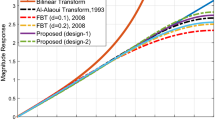Abstract
This paper presents a new optimal second-order design of the infinite impulse response digital differentiator. This design manifests the \(L_1\)-error fitness function’s optimization using the multi-verse optimization algorithm. The optimizing variables are obtained from the direct wave-form-based transfer function. The acquired magnitude response approximates the ideal differentiator with the mean absolute magnitude error − 45.8842 dB. The designed optimal differentiator has also been compared with the existing designs to manifests its efficacy.


Similar content being viewed by others
Explore related subjects
Discover the latest articles and news from researchers in related subjects, suggested using machine learning.Data Availability
The data that support the findings of this study are available from the corresponding author on request.
References
A. Aggarwal, T.K. Rawat, D.K. Upadhyay, Optimal design of \(L_1\)-norm based IIR digital differentiators and integrators using the bat algorithm. IET Signal Process. 11(1), 26–35 (2017). https://doi.org/10.1049/iet-spr.2016.0010
M.A. Al-Alaoui, Novel FIR approximations of IIR differentiators with applications to image edge detection, in 18th IEEE International Conference on Electronics, Circuits, and Systems, Beirut (2011), pp. 554–558. https://doi.org/10.1109/ICECS.2011.6122335
M.A. Al-Alaoui, Using fractional delay to control the magnitudes and phases of integrators and differentiators. IET Signal Process. 1(2), 107–119 (2007). https://doi.org/10.1049/iet-spr:20060246
M.A. Al-Alaoui, Class of digital integrators and differentiators. IET Signal Process. 5(2), 251–260 (2011). https://doi.org/10.1049/iet-spr.2010.0107
M.A. Al-Alaoui, M. Baydoun, Novel wide band digital differentiators and integrators using different optimization techniques, in International Symposium on Signals, Circuits and Systems (ISSCS2013) (2013). pp. 1–4. https://doi.org/10.1109/ISSCS.2013.6651225
H. Faris, M.A. Hassonah, A.M. Al-Zoubi, S.M. Mirjalili, I. Aljarah, A multi-verse optimizer approach for feature selection and optimizing SVM parameters based on a robust system architecture. Neural Comput. Appl. 30, 2355–2369 (2018). https://doi.org/10.1007/s00521-016-2818-2
A. Fettweis, Wave digital filters: theory and practice. Proc. IEEE 74, 270–327 (1986). https://doi.org/10.1109/PROC.1986.13458
O.P. Goswami, T.K. Rawat, D.K. Upadhyay, A novel approach for the design of optimum IIR differentiators using fractional interpolation. Circuits Syst. Signal Process. 39, 1688–1698 (2020). https://doi.org/10.1007/s00034-019-01211-0
O.P. Goswami, T.K. Rawat, D.K. Upadhyay, Fractional interpolation and multirate technique based design of optimum IIR integrators and differentiators. Int. J. Electron. 66, 1–15 (2021). https://doi.org/10.1080/00207217.2020.1870730
L.D. Grossmann, Y.C. Eldar, An \(L_1\)-method for the design of linear-phase FIR digital filters. IEEE Trans. Signal Process. 55(11), 5253–5266 (2007). https://doi.org/10.1109/TSP.2007.896088
M. Gupta, B. Relan, R. Yadav, V. Aggarwal, Wideband digital integrators and differentiators designed using particle swarm optimisation. IET Signal Process. 8(6), 668–679 (2014). https://doi.org/10.1049/iet-spr.2013.0011
M. Jain, M. Gupta, N. Jain, Linear phase second order recursive digital integrators and differentiators. Radio Eng. J. 21(2), 712–717 (2012)
M. Kumar, T.K. Rawat, Optimal design of FIR fractional order differentiator using cuckoo search algorithm. Expert Syst. Appl. 42(7), 3433–3449 (2015). https://doi.org/10.1016/j.eswa.2014.12.020
V. Lesnikov, T. Naumovich, A. Chastikov, Number theoretical analysis of the structures of classical IIR digital filters, in 7th Mediterranean Conference on Embedded Computing (MECO), Budva, Montenegro (2018). https://doi.org/10.1109/MECO.2018.8406099
S. Mirjalili, S.M. Mirjalili, A. Hatamlou, Multi-verse optimizer: a nature-inspired algorithm for global optimization. Neural Comput. Appl. 27, 495–513 (2016)
T.K. Rawat, Digital Signal Processing (Oxford University Press, Oxford, 2014)
J.H.F. Ritzerfeld, Noise gain expressions for low noise second-order digital filter structures. IEEE Trans. Circuits Syst. II Express Briefs 52(4), 223–227 (2005). https://doi.org/10.1109/TCSII.2004.842415
J.H.F. Ritzerfeld, The direct wave form digital filter structure: an easy alternative for the direct form, in Proceedings of the 15th ProRISC, Annual Workshop on Circuits, Systems and Signal Processing (ProRISC 2004), Netherlands (2004). pp. 133–137
S.K. Saha, S.P. Ghosal, R. Kar, D. Mandal, Cat swarm optimization algorithm for optimal linear phase FIR filter design. ISA Trans. 56(6), 781–794 (2013)
G.I. Sayed, A. Darwish, A.E. Hassanien, Quantum multiverse optimization algorithm for optimization problems. Neural Comput. Appl. 31, 2763–2780 (2019). https://doi.org/10.1007/s00521-017-3228-9
M.I. Skolnik, Introduction to Radar Systems, 2nd edn. (McGraw & Hill, New York, 1980)
D.K. Upadhyay, Class of recursive wideband digital differentiators and integrators. Radioengineering 21(3), 904–910 (2012)
Author information
Authors and Affiliations
Additional information
Publisher's Note
Springer Nature remains neutral with regard to jurisdictional claims in published maps and institutional affiliations.
Rights and permissions
About this article
Cite this article
Goswami, O.P., Rawat, T.K. & Upadhyay, D.K. \(L_1\)-Norm-Based Optimal Design of Digital Differentiator Using Multiverse Optimization. Circuits Syst Signal Process 41, 4707–4715 (2022). https://doi.org/10.1007/s00034-022-02003-9
Received:
Revised:
Accepted:
Published:
Issue Date:
DOI: https://doi.org/10.1007/s00034-022-02003-9




